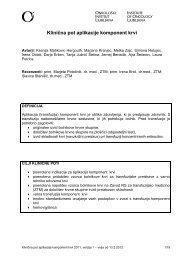Create successful ePaper yourself
Turn your PDF publications into a flip-book with our unique Google optimized e-Paper software.
Non-immortalized somatic neural stem cell line – possible<br />
implementation for developmental neurotoxicity and oncological<br />
research<br />
Leonora Buzanska1 ,2, Krystyna Domanska Janik1, Hanna Winiarska1, Sandra Coecke2<br />
1Medical Research Center, Warsaw, Poland; 2European Commission - DG JRC, IHCP-ECVAM, Italy<br />
The promise held by neural stem cells (NSC) for the cell therapy <strong>of</strong> neurodegenerative<br />
and oncological disorders is now widely accepted and stem cell research is focused on this<br />
aspect <strong>of</strong> NSC application. In parallel, the NSC culture can be considered a model system<br />
for in vitro screening <strong>of</strong> putative toxic or transforming factor effects on their proliferation,<br />
viability and differentiation potential into neuronal cells. However, both the ethically<br />
controversial sources <strong>of</strong> the NSC (human embryos or foetuses) and the limited life-span<br />
<strong>of</strong> the somatic NSC cultures make these studies difficult. These two challenges were faced<br />
by our group by showing the possibility <strong>of</strong> differentiation <strong>of</strong> the stem cells isolated from<br />
Human Umbilical Cord Blood (HUCB) into neuronal cells (Buzanska et al., J.Cell Sci.,<br />
115; 2002) and further by generating the first, non-transformed, clonal and karyotypically<br />
stable somatic neural stem cell line “HUCB-NSC” (Buzanska et al., Stem Cells Dev., 15;<br />
2006). Over six years <strong>of</strong> culturing, these cells have revealed a stable growth rate, an ability<br />
to self-renew and the maintenance <strong>of</strong> differentiating potential into neuronal, astroglial<br />
and oligodendroglial cells. The HUCB-NSC can be expanded and halted in culture at<br />
different developmental stages – from floating non-differentiated stem cells to committed<br />
progenitors and differentiated neuronal cells (Buzanska et al., Tox In Vitro., 19; 2005). The<br />
developmental stages <strong>of</strong> HUCB-NSC have been truly characterized by transcriptional<br />
pr<strong>of</strong>iling, immunocytochemistry and electrophysiological studies, thus HUCB-NSC as<br />
a non–immortalized stem cell line can serve as an alternative, human-based model for in<br />
vitro oncogenic transformations and developmental neurotoxicity studies.<br />
p7<br />
89
















